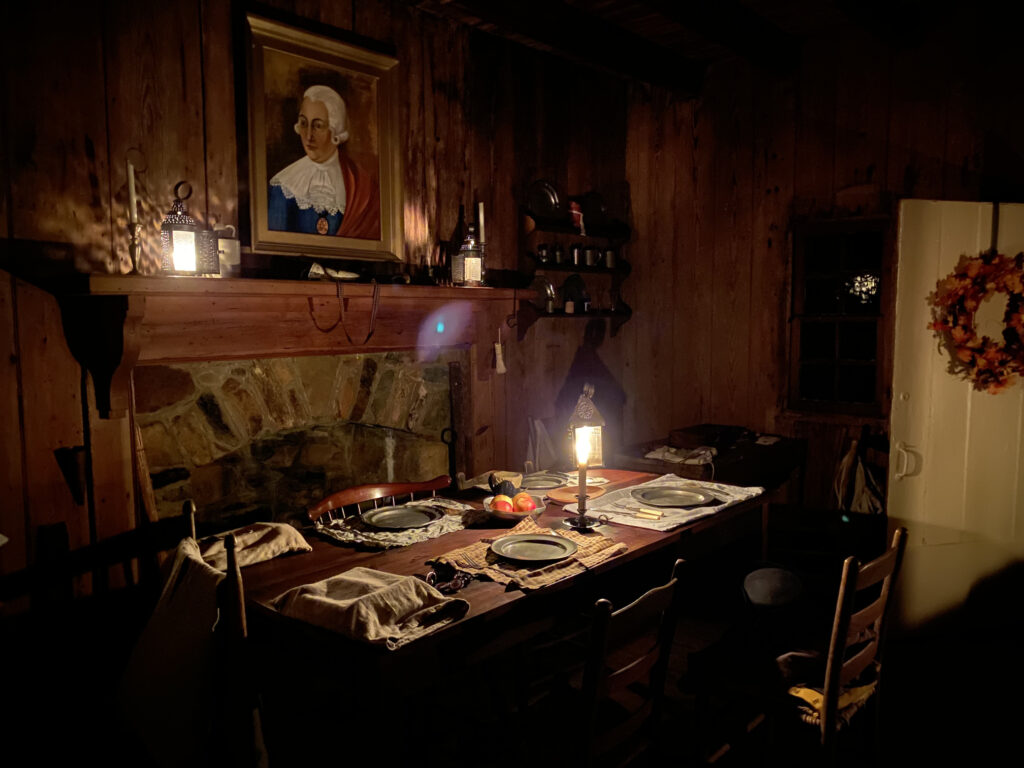
**This research was first published in the May 1, 2024 edition of the Chatham Star-Tribune newspaper as part of Kyle Griffith’s weekly segment entitled “Heritage Highlights.”

A typical candle-lit tavern scene at Yates Tavern near Gretna at night.
Prior to the mid-1800’s, rural taverns were an integral part of business concerning travel and social organization. The buildings were typically positioned along common roads between main towns to attract travelers. For distant farmers returning home from town, traveling politicians, and locals alike, taverns served four main functions. A reliable tavern prepared filling meals, served a variety of drinks from the bar, offered a place to sleep overnight, and provided care for the guests’ horses. In addition, the centralized locations often served as a source of local and worldly news, meeting places for fraternal societies, and muster grounds for the militia.
Licensed taverns usually featured a simple interior with basic accommodations. The main tap room housed the bar and dining area. The word “bar” is a shortened version of the full name, “caged barrier.” Its primary purpose was security against theft of the valuable spirits and glassware. Additionally, the barrier offered a level of protection for the barkeeper who worked to fulfill orders. Some taverns had several rooms for lodging while others offered one room to accommodate all guests. The kitchen for the tavern was commonly a separate building in itself, often accompanied by a smokehouse. The official state license to operate an “ordinary” (interchangeable with “tavern”) detailed that the business must provide cleanly lodging and wholesome diet for travelers. Also, suitable horse stables or pasturage with necessary food and water was expected. It was forbidden to “suffer or permit unlawful gaming,” but that rule didn’t stop those determined to gamble. Lastly, the license details guests shall not “tipple or drink any more than is necessary” on the Sabbath Day. Whether or not the rules were maintained, especially in rural taverns, was left to the abilities of the tavern keeper.
A journal kept by William Loughton Smith of South Carolina in 1791 recounted several vivid experiences in taverns around southern Virginia. One entry began, “I passed this afternoon several small taverns, and traveled an hour after dark to reach Billy George’s because it was recommended as the best, but I found it bad enough; there was neither rum or sugar; he borrowed some rum from a neighbor….The bugs made a heartier supper on me than I did on my bacon and eggs.” Smith passed by Moore’s Ordinary, proceeded to cross the Staunton River on a ferry with horses during a thunderstorm. Drenched, Smith journeyed through Pittsylvania County and stopped for dinner with Col. Isaac Coles at Coles Ferry before he continued on south. He spent the night at Pridie’s Tavern, near the Banister River, which Smith had few good words about. “My fare was indifferent, and as I was kept awake a great part of the night by bugs and fleas, and the united groaning and grunting of the hogs under the window…enlivened by the perpetual peals of thunder and the rattling of heavy rain on the shingles over my head.” He left early in the morning and traveled to find “a decent breakfast” at Halifax Old Town (Peytonsburg). Smith recounted eight miles of “an abominable road, consisting of stumps, roots, stones, gullies, steep hills, etc. on the way to a tavern kept by “Colonel Dix.” The stay may have been comfortable, except for a sick mother and child who cried for the entire night. Smith wrote that at bedtime, the mother “commenced the most dreadful howling, screaming, and groaning I ever heard.” After little sleep, the next day he crossed Dix’s Ferry on the Dan River, ascended “a very steep hill on the other side” and entered North Carolina.
To conclude, tavern keeping was a necessary business for the common systems of life during the 18th and early 19th centuries. The concept of a tavern gradually transformed into more specialized businesses known as saloons, hotels, restaurants, inns, and other regional variations. W. L. Smith’s journal is not a reflection of all taverns of his time, and there were certainly others to praise throughout southern Virginia. Due to the infancy of the legal system, minimal health standards, and the rugged expanse of the Piedmont over 200 years ago, tavern service ranged drastically. From comfort and wonderful hospitality to an abysmal and unfulfilling experience, it was hard to know what travelers would endure each night as they ventured closer to their destination.

Thos. B. Fowler